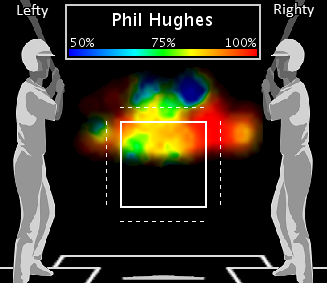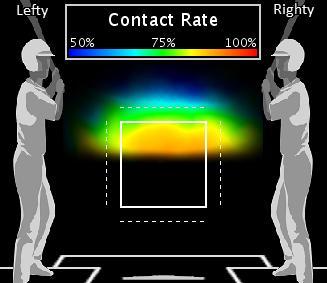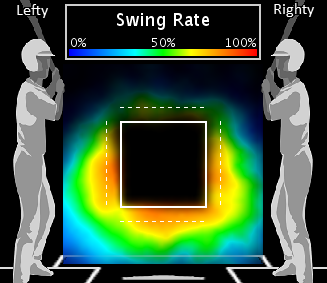Phil Hughes Getting Lit Up in 2-Strike Counts
 David Golebiewski |
David Golebiewski |  Tuesday, December 17, 2013 at 6:00AM
Tuesday, December 17, 2013 at 6:00AM
The Minnesota Twins' starting rotation has failed to put hitters away for years now. In 2013, Twinkies starters had the lowest strikeout rate (12.3 percent of batters faced) and allowed the highest two-strike slugging percentage (.355) in the majors. Minnesota signed Ricky Nolasco and Phil Hughes for a combined $73 million to add some Ks to a chronically underpowered staff, but the latter hurler might actually make the club's problem in finishing off opposing batters worse.
Hitters are typically toast by the time they get down to their last strike, slugging just .274 in such situations during the 2013 season. Not against Hughes, though. The erstwhile Yankee prodigy served up 10 home runs in two-strike counts (tied for seventh-most among starting pitchers) and surrendered a .399 slugging percentage. Among pitchers making at least 20 starts last year, only Roberto Hernandez (.405) and Joe Sauders (.404) let hitters do more two-strike damage. The two names directly following Hughes look depressingly familiar to Twins fans: Scott Diamond and Kevin Correia (both at .394).
Why has Hughes, a former top-five prospect who barely has a better career park-and-league-adjusted ERA (five percent below average) than the undrafted Diamond (eight percent below), been so hittable in two-strike counts? The 27-year-old tries to overpower batters, elevating his fastball and nearly scrapping his curveball in favor of a speedier slider. Unfortunately, hitters are making loud, frequent contact against Hughes' supposed put-away pitches.
In two-strike situations, Hughes relies almost exclusively on his fastball (thrown 51 percent of the time) and slider (40 percent). He goes for the kill with the fastball, throwing it harder with two strikes (92.7 MPH) than in other counts (92.2 MPH) and peppering the upper third of the strike zone. Hughes threw 56 percent of his two-strike fastballs high in the zone last year, far above than the 42.5 percent average for MLB starters. Pitchers tend to miss bats with elevated two-strike heaters, but Hughes allowed scads of contact.
Hughes' fastball contact rate in 2-strike counts, 2013

Average fastball contact rate in 2-strike counts, 2013

Hitters came up empty a mere 13.9 percent of the time that they swung against a high Hughes fastball, compared to the 22 percent average for starters. Correia (14 percent) actually got as many whiffs when he climbed the ladder. It's probably not a good sign when your fastball can be described as Correia-esque.
Hughes' slider also suffers from a lack of swings and misses with two-strikes (27.1 percent, below the 30 percent average), largely because hitters don't chase the pitch outside of the strike zone. Check out opponents' swing rate on two-strike sliders thrown off the plate against Hughes, and then the MLB average.
Hitters' swing rate by pitch location vs. Hughes' two-strike sliders, 2013

MLB average swing rate by pitch location vs. two-strike sliders, 2013

Overall, hitters chased two-strike sliders out of the strike zone 43.5 percent of the time. But against Hughes? Just 35.6 percent. That's below both Mike Pelfrey (36.6 percent) and Correia (38.8 percent).
As the game's most fly ball-centric pitcher, Hughes will undoubtedly benefit in moving from Yankee Stadium (which has boosted home runs by 19 percent compared to a neutral park over the past three years, per The Bill James Handbook) to Target Field (which has suppressed homers by nine percent). But when it comes to burying hitters, he has far too much in common with his new teammates.
 Free Agents,
Free Agents,  Twins,
Twins,  Yankees,
Yankees,  two-strike counts | tagged
two-strike counts | tagged  Minnesota Twins,
Minnesota Twins,  New York Yankees,
New York Yankees,  Phil Hughes,
Phil Hughes,  Ricky Nolasco,
Ricky Nolasco,  strikeouts,
strikeouts,  two strike counts
two strike counts
